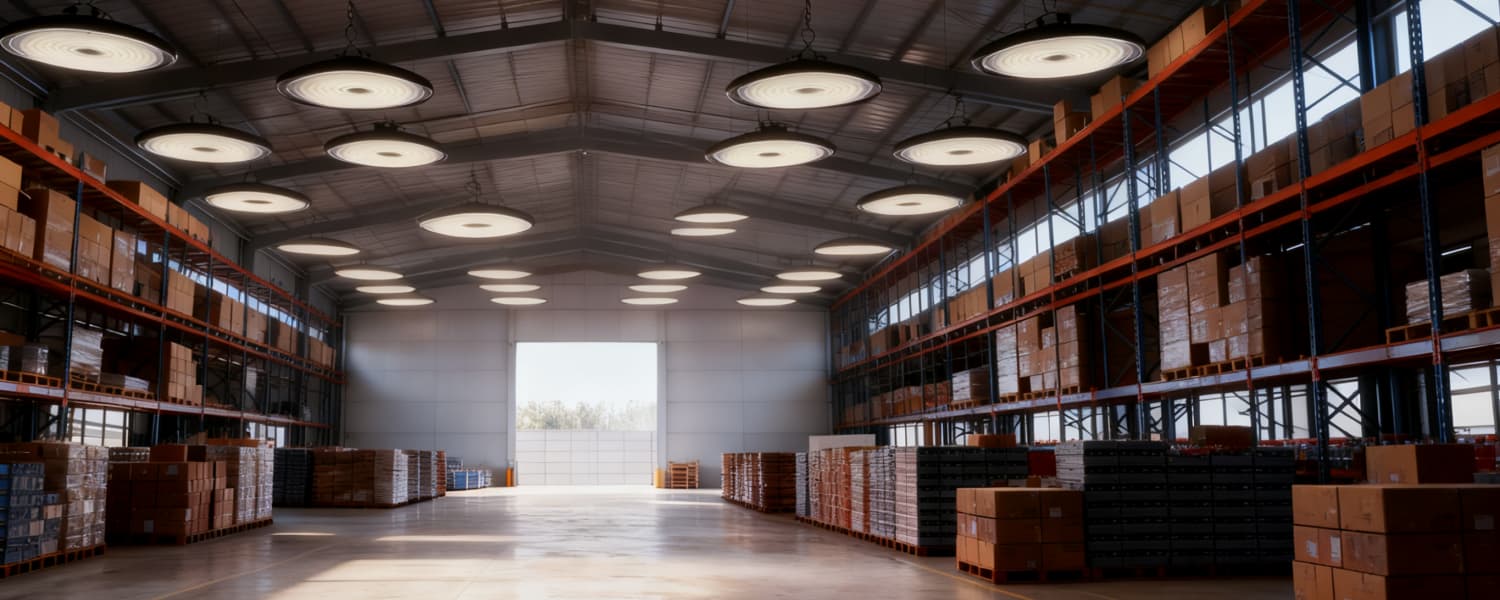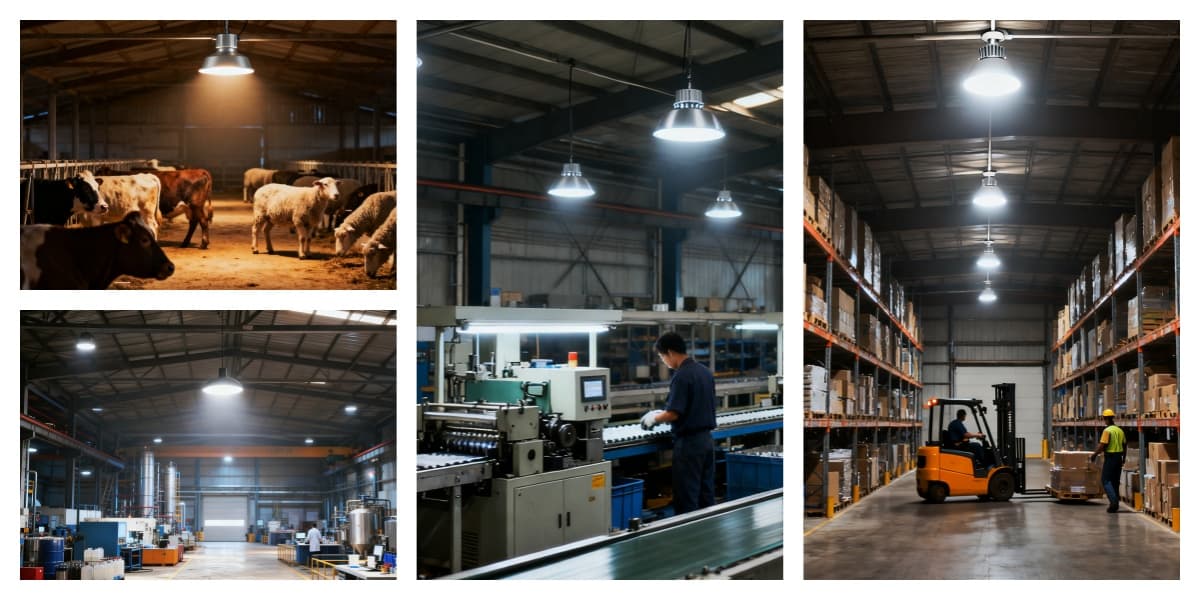High Bay LED Lights Guide

Table of Contents
High Bay LED Light vs Traditional Metal Halide / HPS
Key Benefits of LED High Bay Lighting
How to Choose the Best High Bay LED Shop Lights?
Applications of Industrial High Bay LED Lighting
What Are High Bay LED Lights?
High bay LED lights are designed for spaces with ceilings typically above 6–12 meters. At this height, ordinary lights can’t deliver enough brightness or uniform coverage, so high bay fixtures are built with higher lumen output, optimized beam angles, and better heat management to ensure consistent lighting across large areas.
They are commonly used in:
Warehouses and logistics centers
Manufacturing plants and workshops
Gymnasiums, hangars, supermarkets, exhibition halls
High Bay vs Low Bay — What’s the Difference?
Feature | High Bay LED Lights | Low Bay LED Lights |
Ceiling height | Above 6–12 m | 4–6 m |
Beam angle | Narrower (60°–120°) to focus light downwards | Wider to cover short distance |
Lumen output | Higher, usually 15,000–40,000 lm | Lower, suitable for retail or small workshops |
In simple terms, if the ceiling is high and the space is wide, you need high bay LED lighting to avoid dim spots and shadows.
If you want to learn more about the differences between high bay and low bay lighting, check this blog: High Bay vs Low Bay Lighting: What is the Real Difference?
Types of LED High Bay Lights
There are many different functional areas in industrial spaces , which is why high bay LED lights come in different shapes and mounting designs. Choosing the right type helps improve lighting efficiency, reduces glare, and ensures light reaches where it is needed most.
1. Round/UFO High Bay Lights
UFO LED high bay lights are round, compact, and designed for high ceilings. Their circular structure provides a wide and uniform light beam, making them ideal for:
Manufacturing plants
Gymnasiums and sports halls
Airports and hangars
Pros
Slim design, easy to install with a hook or bracket
Better heat dissipation due to aluminum housing
High output (100W–240W) with 150–160 lm/W
Cons
Less suitable for narrow aisles or racking systems
2. Linear High Bay Lights
Linear high bay lights look like long rectangles, similar to traditional fluorescent fixtures. They distribute light in a rectangular pattern, making them perfect for structured spaces.
Best for:
Aisle-style warehouses with tall shelving
Supermarkets and retail stores
Production lines
3. Retrofit High Bay Kits & High Bay Shop Lights
These are designed to upgrade old metal halide or fluorescent fixtures without replacing the entire fixture body.
Common uses:
Small workshops and garages
Retail shops with high ceilings
Facility upgrades where budget and installation time are limited
✅ Comparison Table
Type | Ideal Applications | Advantages | Limitations |
UFO LED High Bay Light | Factories, gyms, hangars | Compact size, high brightness, excellent heat dissipation | Not ideal for aisles or long shelving layouts |
Linear LED High Bay | Warehouses, supermarkets, logistics centers | Uniform light over aisles and shelves, easy to align with racking | Larger in size, heavier to install |
Retrofit Kits / High Bay Shop Lights | Garages, small warehouses, retail shops | Cost-effective upgrade, minimal rewiring | Lower output compared to full high bay fixtures |
High Bay LED Light vs Traditional Metal Halide / HPS
Many warehouses and factories are still using metal halide (MH), high-pressure sodium (HPS), or fluorescent high bays. While these technologies were once the industry standard, they come with high energy use, short lifespans, and frequent maintenance. LED high bay lights solve most of these issues.
1. Common Traditional High Bay Options
Traditional Light Type | Typical Use |
Metal Halide (MH) | Stadiums, old factories, industrial lighting |
High-Pressure Sodium (HPS) | Warehouses, parking lots, street lighting |
Fluorescent High Bay (T5/T8) | Retail stores, small workshops, gyms |
2. Performance Comparison: LED vs Traditional Lights
Feature | LED High Bay | Metal Halide (MH) | High-Pressure Sodium (HPS) | Fluorescent |
Luminous Efficiency | 130–160 lm/W | 70–90 lm/W | 80–110 lm/W | 60–90 lm/W |
Startup Time | Instant (0.5s) | 5–10 minutes | 2–5 minutes | Instant |
Lifespan | 50,000–100,000 hours | 10,000–15,000 hours | 15,000–24,000 hours | 20,000–30,000 hours |
Maintenance Cost | Very low | High (bulb + ballast replacement) | Medium | Medium |
Heat Output | Low | Very high | High | Medium |
Color Rendering (CRI) | ≥80 | 60–70 | 20–30 (yellowish) | 70–80 |
Energy Consumption | Lowest | High | Medium-high | Medium |
3. Why LED Is the Better Choice
✔ Up to 70% energy savings compared to MH or HPS
✔ No warm-up time — LEDs switch on instantly
✔ Longer lifespan = fewer replacements and lower labor cost
✔ Better light quality (CRI, uniformity, no flicker)
✔ Less heat generated, reducing air-conditioning load in factories or warehouses
✔ Optional smart features: dimming, motion sensors, wireless control
In short, switching from metal halide or fluorescent high bay lights to LED is not just a trend — it’s a long-term cost-saving decision.
Key Benefits of LED High Bay Lighting
High bay LED lights are now the preferred choice for warehouses, factories, and other large facilities because they offer better performance with lower operating costs. The main advantages include:
1. Up to 70% Energy Savings
Traditional metal halide or HPS high bays consume 250W–400W per fixture. An LED replacement often uses only 100W–150W while delivering the same or even higher brightness. This means:
Less electricity consumption
Lower monthly utility bills
Faster ROI for industrial facilities
2. Longer Lifespan, Less Maintenance
LED high bay lights typically last 50,000–100,000 hours, while metal halide bulbs only last around 10,000 hours.
This reduces:
Frequent bulb replacements at high ceiling heights
Labor costs for maintenance crews
Production downtime in factories or warehouses
3. Bright, Uniform, and Comfortable Lighting
High lumen output ensures clear visibility from floor to ceiling
High CRI (≥80) shows true colors of products, machinery, and safety signs
No flicker or buzzing — improves visual comfort and worker productivity
Uniform light distribution reduces dark spots and shadows
4. Durable & Industrial-Grade Protection
Most high bay LED fixtures are built with:
IP65 waterproof and dustproof rating
Aluminum housing for fast heat dissipation
Impact-resistant lenses for harsh industrial environments
5. Smart Control & Dimming Options
LED high bay lights can be integrated with:
0–10V dimming systems
Motion sensors (turns on only when someone is present)
Daylight sensors and wireless control systems
These features help save additional energy and make lighting automation easier to manage.
How to Choose the Best High Bay LED Shop Lights?
Selecting the right high bay LED light is not just about wattage. The goal is to match brightness, beam angle, installation method, and working environment to your facility’s needs. Here’s what to consider:
1. Wattage Replacement (100W / 150W / 200W)
LED lights use much less power than metal halide (MH) lamps to produce the same brightness.
Metal Halide (MH) | LED Replacement | Typical Use |
250W | 100W LED | Small workshops, garages |
400W | 150W LED | Standard warehouse, factories |
600W | 200W LED | Gymnasiums, logistics centers |
Choose based on ceiling height, required lux level, and working area size.
2. Lumens & Lighting Efficiency
Look for lights with ≥150 lm/W.
Higher lumens per watt = more light with less energy.
Example: A 150W LED at 150 lm/W = 22,500 lumens.
3. Color Temperature (CCT)
CCT Range | Light Color | Suitable For |
4000K | Neutral white | Warehouses, assembly lines |
5000K | Cool daylight | Manufacturing, inspection areas |
5700K+ | Very cool white | Outdoor or high-contrast tasks |
4000–5000K is the most comfortable range for industrial lighting—bright, but not overly cold.
4. CRI (Color Rendering Index)
CRI ≥80 is recommended for areas where color accuracy matters (inspection, packaging, quality control).
Low CRI lights can distort colors and increase visual fatigue.
5. IP Rating, Glare & Beam Angle
Feature | What to Consider |
IP Rating | IP65 or above for dust, moisture, and oil-resistant environments |
UGR (Glare Control) | Low UGR lenses or diffusers help prevent glare in workplaces |
Beam Angle | 60° for high ceilings, 90° for general lighting, 120° for open areas |
6. Mounting Options
Mounting Type | Description | Best For |
Hook Mount | Quick installation, most common | Warehouses, workshops |
Chain Mount | Adjustable height | Retail, supermarket aisles |
Bracket / Surface Mount | Fixed and stable | Low ceilings, sloped roofs, tunnels |
✅ Quick Checklist Before Buying
✔ Does it replace your current MH or HPS wattage?
✔ Does it provide at least 150 lm/W?
✔ Is the color temperature suitable for the working environment?
✔ CRI higher than 80?
✔ IP65 or higher for harsh conditions?
✔ Right beam angle and mounting method for your ceiling?
Applications of Industrial High Bay LED Lighting
High bay LED lights are designed for large spaces with high ceilings, where bright, uniform, and energy-efficient lighting is essential for safety and productivity. Below are the most common applications and how LED high bays improve each environment.

1. Warehouses and Logistics Centers
Provide uniform illumination between tall racks and storage aisles
Reduce shadows and dark corners to improve forklift safety
Optional motion sensors help save energy in low-traffic areas
2. Manufacturing Plants and Workshops
High CRI and flicker-free lighting improve accuracy in assembly and inspection tasks
With low heat output, LEDs create a more comfortable workstation
Durable aluminum housing resists dust, oil, and vibration in factory settings
3. Livestock Barns
Adjustable color temperature simulates natural light, boosting livestock growth and feed conversion
Sealed, corrosion-resistant housing resists moisture and waste, ensuring long-term use
Energy-efficient design cuts costs for 24-hour lighting needs in barns
4. Chemical Environment
Explosion-proof design meets safety standards for flammable chemical spaces
Corrosion-resistant coating withstands acidic/alkaline fumes, avoiding damage
Stable light output without flicker ensures clear visibility for chemical operations
5. Cold Storage & Food Processing Facilities
LEDs perform well in low temperatures (–30°C and below)
No glass tubes or toxic materials, safer for food-related environments
Lower heat emission helps maintain stable refrigeration conditions
In short: wherever ceilings are high and safety, energy efficiency, and visibility matter, high bay LED lights are the most reliable solution.
Conclusion
High bay LED lights offer a smarter solution for industrial and commercial spaces. They cut energy consumption by up to 70%, reduce long-term maintenance costs, deliver bright and uniform lighting, and ensure safer working environments. Whether it’s a warehouse, factory, gym, or logistics center, LED high bay lighting provides reliable performance and long service life.
Ceramiclite specializes in energy-efficient industrial lighting and offers customized lighting plans to match your space layout, mounting height, and brightness requirements. Our HB01 LED High Bay Light delivers high lumen output, excellent heat dissipation, IP65 protection, 10-year warranty, and optional smart control systems.
Ready to upgrade your lighting? Get a free lighting plan or quote from Ceramiclite today.
FAQs
Q1. How many lumens do I need for a warehouse?
It depends on the work environment and ceiling height. General storage areas need around 10,000–20,000 lumens per fixture, while assembly or inspection areas may require 20,000–30,000 lumens to meet 300–500 lux standards.
Q2. What mounting height suits high bay LED lights?
High bay lights are designed for ceilings over 6 meters (20 ft).
6–9 m (20–30 ft): 100W–150W fixtures
9–12 m (30–40 ft): 150W–200W fixtures
Above 12 m (40 ft): 200W–300W fixtures with narrower beam angles
Q3. Can high bay LED lights be dimmed or used with motion sensors?
Yes. Most modern high bay LEDs, including Ceramiclite’s HB01, support 0–10V or DALI dimming, motion sensors, and even smart controls via apps or IoT systems to reduce power consumption when no one is around.
Q4. What is the lifespan of high bay LED lighting?
Quality fixtures last 50,000–100,000 hours, depending on heat management and usage. Ceramiclite HB01 offers up to 100,000 hours with a 10-year warranty, reducing replacement and maintenance costs.
Q5. High bay vs low bay – how to choose?
The difference mainly lies in mounting height and beam angle:
Low bay lights: For ceilings below 6 meters (20 ft), wider beam spread.
High bay lights: For ceilings above 6 meters, higher wattage and focused light distribution.
Choose based on ceiling height, required brightness, and application.
_thumb.jpg)
